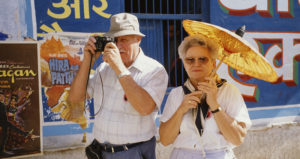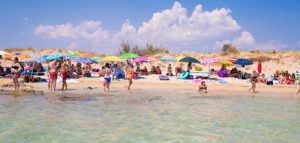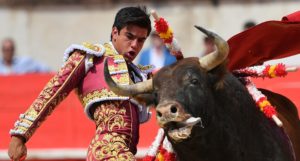In the mid-Twenties, the author Ada Harrison visited Majorca and discovered that it had “fallen to Britain”. Majorca had “become one of those places which, the English say, are being ruined by the English”. The result was that the Hotel Continental in the Majorcan capital Palma was largely occupied by suspicious guests demanding “a diet of roast beef and rice pudding”.
By 1931, there was an air service with two daily flights to Palma from mainland Spain and another from Marseilles. According to the 1933 Lindo guide, the journey from London, by air with two stopovers, now took less than 48 hours — even though at the airport, even in the Fifties, passengers’ luggage was still collected by horse and cart and taken to their hotel. By 1935, with 135 hotels on the island, 71 of them in Palma, the number of tourists had more than doubled: there were 40,000 hotel stays and 50,000 cruise visitors.
The poet Robert Graves, Majorca’s most famous British resident, looked on with dismay from his eyrie in the village of Deià. “About 1931, a small tourist boom began, which troubled me despite such advantages as being now able to buy in Palma cow’s milk, beef, butter, teapots, kettles, beer and ready-made sheets, none of which had hitherto been procurable,” he wrote. When Graves had moved to Deià in 1929, there was already a small colony of British exiles in El Terreno, in flight from thrifty budgeting and rain, and he described them as “retired civil servants from Asian and African dependencies, who had not dared face either the English climate or the high cost of domestic help at home”.
By the time Robert Trimnell set out the island delights in his first guide to Palma in 1955, it had become host to a new style of post-war middle-class English expatriatism: easy-going, blazer-wearing, louche but resolutely unbohemian. It was boozy and jovial, at ease with a bit of undemanding culture but more at home on the golf course: retirement in the sun with every amenity.
Air travel meant saving time. And on a beach holiday that was time saved to do nothing. There was very little that was educative or high-minded about the new kind of holiday — no jolly character-building while roughing it or tramping over the hills singing “Strawberry Fair”. The new beach holiday meant doing nothing but basking and getting a tan, perhaps a little swimming, and certainly a lot of eating and drinking.
By this time tourists didn’t even have to make do with just Majorcan culture: there was a wide range of other cultures on tap. In the 1964 edition of the guide, Trimnell notes that in Palma you can buy Italian silk ties and Pringle jumpers; you can “drink your draught beer in a bullring” in the El Toro bullfighter-themed bar. And then there was the South African-owned “Africa Bar” where, in a typical bit of touristic cultural dissonance, you can eat “the best pizza, spaghetti, lasagne and Italian salads in town”.
Trimnell’s Palma is a theme park of pseudo-Balearic experience carefully tailored to feel, with its hair salons, pubs and golf courses, almost like home — but cheaper, boozier and warmer. In this enclosed world, everything is provided, and little demanded of the tourist except ready cash.
Graves was as much enamoured of the simple living and sun-engendered spontaneity as any bohemian creative of the Twenties. But in the post-war years, he found the Majorcan beaches increasingly debased by rows of passive sun-tanners. Graves reflected that they had no idea that it was really all about sex:
“The average emancipated Englishwoman associates the Sun with an idyll of lying scantily clad on a nice hot sandy beach, while a bronzed lover — and incarnation of the Sun — mutters fiery and unintelligible endearments in her chaste ear. Probably she has been reading that crazy D. H. Lawrence, England’s most fanatical Sun-cult revivalist.”
The sun by then was seen not only as a natural source of health but as a craving, an adulation: it was associated with freedom and uncomplicated sex and natural physical urges. D. H. Lawrence was naturally a keen proponent of this idea. In his 1925 short story Sun, a woman sunbathing on a remote Mediterranean promontory, under doctor’s orders, feels that the rays of the sun are “mating” with her:
“She slid off all her clothes and lay naked in the sun. As she lay she looked up through her fingers at the central sun, his blue, pulsing roundness, whose outer edges streamed brilliance. Pulsing with marvellous blue, and alive, and streaming white fire from his edges, the sun! He faced down to her with his look of blue fire, and enveloped her breasts and her face, her throat, her tired belly, her knees, her thighs and her feet.”
The novelty of all-inclusive holidays in the sun, devoid of any expectations of culture, made acceptable the notion of two weeks of self-indulgence and pure enjoyment. Respectable mores could be left behind on a package holiday, where the sexes mingled freely on the beach in revealing bathing costumes. The all-you-can-eat buffets were an almost unimaginable luxury after rationing. The heat, the swimming, and exotic food were part of the experience, but for tourists coming from an urbanised, industrialised Britain, it was also deliriously romantic and mind-expanding.
By 1953, two million British a year were holidaying abroad — half a century later, in 2000, the figure would be 30 million. In 1938, the Holidays with Pay Act had mandated a week’s paid annual leave for all industrial workers. Wages had gone up sharply during the post-war labour shortages: average weekly earnings between 1955 and 1960 rose by 34%.
In many places, notably Franco’s Spain, cultural clashes were inevitable. The distinctiveness of ordinary life was made artificial by being constantly watched and photographed — or was simply erased. The nature of the traditional evening paseo in Spain, for example, when the local young men and women dress up and walk out to view each other, was altered by the presence of British and German tourists wearing skimpier clothes. In the early Fifties women exposing too much flesh (bathing costumes had to have skirts) were sent home by the Guardia Civil. Robert Graves’s daughter Lucia went to school in England in early Fifties; when she left Majorca, the local girls were kept strictly at home until they became mothers but on her return a few years later she was amazed to see that under the influence of the tourists, they were now out on the beach wearing tiny bikinis.
Graves saw “real” Majorca collapsing under the weight of the incoming crowd, with its chatter, its megaphones and its loud motor vehicles. He saw the destruction of baraka, the “spirit of generations, of place and inheritance and custom but also of kneeling, of divine inspiration, lightning rapture”. Something “real” was being swamped by its own shadow — unreal tat simulating real craftsmanship: fake “gypsies” playing flamenco in bars and “bullfighting posters on which tourists could have their own names printed between those of El Litri and Jaime Ostos”.
By the Seventies, the uniformity of the sun, sea and sand package-tour experience had become a ubiquitous shorthand for uncultured jollification. In the Carry On films, Spain was seen as simply a sunny backdrop against which a motley group of merry British can shed their sexual inhibitions until it’s time to go home. Carry on Abroad (1972) is set on the island resort of “Elsbels”. Spanish women are frighteningly seductive and Spanish men (mostly waiters) wickedly predatory. “Steady on chaps,” say the Brits as they succumb (temporarily). Inhibitions are happily shed behind coy “do not disturb” signs and, at the end of the holiday, the coach returns everyone home to Britain — there to dream of the same thing, same time next year.
Extracted from Tourists: How the British Went Abroad to Find Themselves by Lucy Lethbridge, Bloomsbury
Disclaimer
Some of the posts we share are controversial and we do not necessarily agree with them in the whole extend. Sometimes we agree with the content or part of it but we do not agree with the narration or language. Nevertheless we find them somehow interesting, valuable and/or informative or we share them, because we strongly believe in freedom of speech, free press and journalism. We strongly encourage you to have a critical approach to all the content, do your own research and analysis to build your own opinion.
We would be glad to have your feedback.
Source: UnHerd Read the original article here: https://unherd.com/




